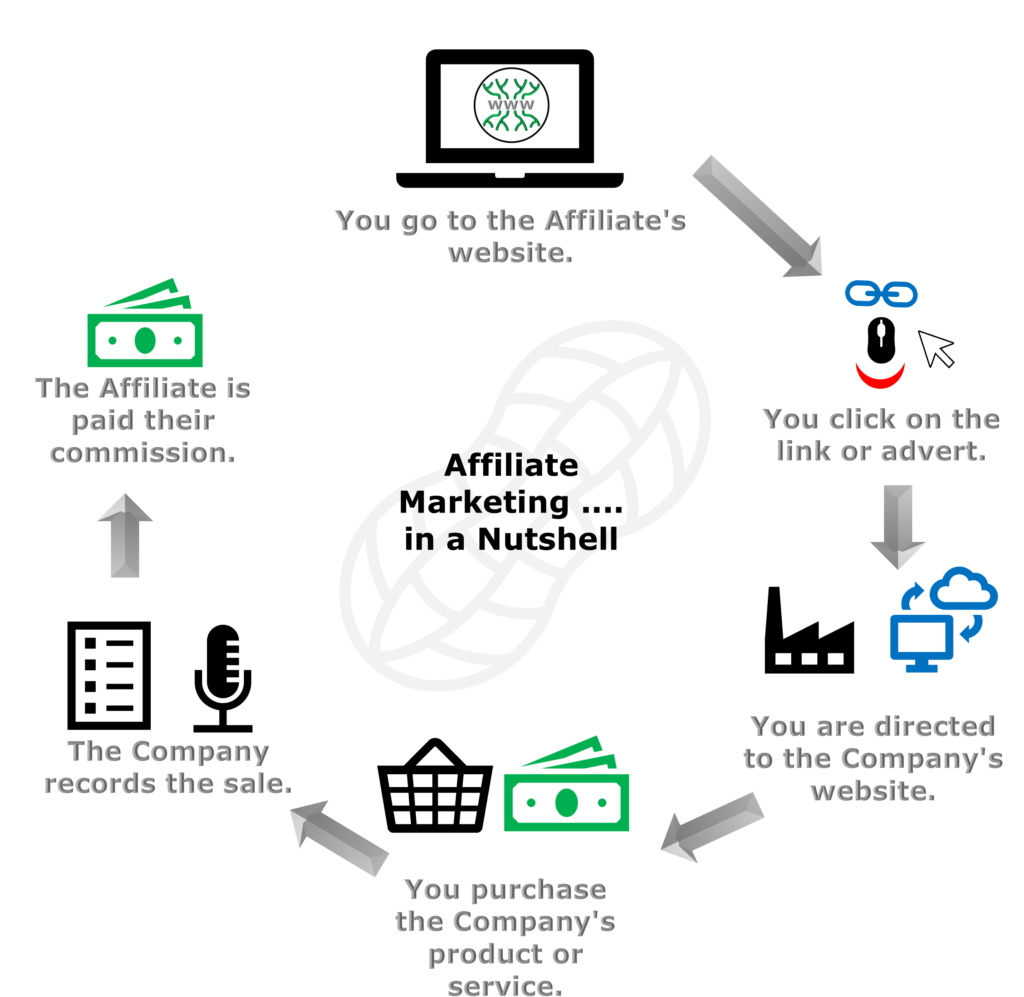Affiliate Marketing

What is Affiliate Marketing …
At its most basic level, Affiliate Marketing is a company paying for Advertising on the sale of its products or services.
There are generally 3 parties in process:
- The Affiliate, the individual or the company advertising the product or service.
- The Brand / The Company selling the Goods or Services.
- The Customer, that would be you (in this article), the end Consumer.
In a nutshell, the following diagram lays out the Affiliate Marketing process:

Why does Affiliate Marketing make sense?
From the selling Company’s point of view
Traditionally a Company would spend money on an Advertising campaign, if sales increased after the campaign, fantastic the campaign must have worked, surely money well spent?
How do you calculate or measure this success?
Perhaps budgeted sales were X and sales exceeded the budget by 10%. Maybe sales increased by 10% versus a comparative period, factoring in the impact of inflation, sales volumes and sales mix … not exactly the most reliable measure. Or perhaps in today’s world they feed the data into some form of AI and let fate decide…
To further complicate matters, the Company’s sales force was hard at work, what portion of the increase in sales are they responsible for?
Measurement by assumptions on top of assumptions … without any assumption this is not ideal, maybe you arrive at the correct answer by mistake.
Money well spent?
This is important, the advertising spend takes place upfront, the cash is gone and there is no guarantee of a sale. The advertising agency receives a payment regardless of the campaign’s success … unless a few performance clauses were placed in the contract … unlikely.
The Company is financing the hope of a sale. The campaign may be successful even if the measurement thereof is complex and a bit of a guess. What may be considered a “targeted” advertising campaign, is still a shotgun approach.
This is where Affiliate Marketing comes in …
With Affiliate Marketing, the payment and expense for the advertising only takes place after the sale (or an event has taken place, such as a free trial registration) … improving cashflow. The advertising is targeted and is measurable.
This just makes sense, the Company only pays for the advertising if there is a sale, no sale … no advertising expense. They don’t Pay per Click, they pay per sale. In theory the advertising expense will only grow if sales grow.
Finance is “happy” or happier, there no upfront cash payment. Budgeting and the measurement of advertising has just been simplified. The company gets closer to being able to assess the true profitability of a product, with one fewer apportionment of expenses to be done and one less assumption.
The Company is given a greater degree of flexibility in terms of staffing, as not only is the “advertising outsourced” away from the traditional advertising agency, a portion of the sales force has also been “outsourced” without the need of employment contracts, retainers for outsourced 3rd party sales forces, etc.
The Company has a tool that assists them in managing the end of a product lifecycle by still advertising and promoting the products, without throwing money into a campaign that may or may not work. If the product is discontinued at a later point in time the risk of the Company having to undergo a painful restructuring of the sales team is reduced, an exercise where nobody wins. The existing sales force can focus on newer products, sooner as opposed to trying to cover both newer and older products at the same time.
Is traditional advertising still required, of course. Affiliate Marketing should be one part of a balanced mix of advertising, marketing and promotion. This mix would also differ by industry and company.
For smaller speciality businesses, Affiliate Marketing may be more effective if it’s share of the advertising spend is higher.
Regardless of the scale of the entity, the mix of your advertising spend must be carefully assessed … maybe Affiliate Marketing needs to be a bigger slice of that advertising budget.
From the Consumer’s point of view
The Affiliate site that you are visiting is about a matter or subject, that is of interest to you or perhaps it’s addressing a problem that you’ve being trying to resolve. You aren’t being bombarded by endless advertising for items that you aren’t interested in.
Hopefully you are in a place that provides useful information, thought and a bit of entertainment.
The Affiliate has spent time and invested in researching the goods and services, come up with ideas, created content and concepts. If you enjoy the content or it provides a solution to a problem, you have a way of supporting the creator at no additional cost to yourself. In certain instances, with coupon codes or Affiliate specials you may even pay less than you would have. Perhaps you just like the creator 😊 and want to support them and invest in their journey, nothing wrong with that.
In theory you get something that you need or want, based on an informed decision as opposed to coming across the product or service by accident.
Always research any purchase and before buying … always check and ask yourself, do I really need this and can I really afford it. If it’s a want … then double check that you can afford the product or service.
From the Affiliate’s point of view
Well, this is the most straight forward, the Affiliate Marketing Fee is a way of supporting and sustaining their business, in fact their business may depend on it.
Or the Affiliate Income is a useful second revenue stream, that doesn’t negatively impact their Primary employer (A Link to our article on this topic: https://root4plant.com/side-hustles-good-or-bad/ ).
They have spent time and effort to develop their content, done research and taken a risk in starting an enterprise.
High level Contractual Relationships *
There is a contract/legal agreement between the Affiliate and the Company.
There is a contract/legal agreement (contract of sale) between the Company and the Consumer.
There is no contract/legal agreement between the Affiliate and the Consumer.
To repeat, the contract of sale, any risks and rewards linked to the sale, product defects or damages, returns, etc. is between the Company making the sale and the Consumer. There is no involvement in this transaction by the Affiliate.
The Affiliate Fee payment is purely between the Company and the Affiliate, if any Affiliate approaches the Customer for payment of their Affiliate Fee … contact the selling Company directly and get them to handle any dispute. If the Company hasn’t paid the Affiliate Fee, that’s a matter between the Affiliate and the Company that they must resolve, it’s not your problem.

* Please note that this is a high-level theoretical view of the contractual relationships in Affiliate Marketing. The diagram and indeed the wording has been included purely for illustrative purposes. This is not a definitive/all-inclusive illustration of all possible scenarios. This article in no way constitutes legal advice, all jurisdictions and situations are different, obtain the appropriate legal advice for your specific scenario/situation, we are only outlining the broad concept of Affiliate Marketing.
Conclusion
Done correctly, Affiliate Marketing should result in a “win win win” scenario.
The Customer gets something that they need or want. The Affiliate Marketing Fee allows the supporters of the Blog / Creator / Website to support the creator at no cost to themselves.
The Company makes a sale and only pays for advertising costs if there is a sale. The Company does not pay for advertising months in advance of a “hoped for sale”.
The Affiliate generates revenue to support their business or enterprise.
And another thing, a Sales pitch:
Included below are product affiliate links. We may receive a commission if you make a purchase after clicking on one of these links.
Check out a few of our Affiliate links for examples of a few Affiliate Programs that we are trying out, take part in.
As an example, we’ve used Sendinblue to setup our mailing list and we’ve used Astra for our Website Design. To be crystal clear and make the different programs visible, we’ve setup a specific page for our various Affiliate Programs, so that those programs are very visible and not hidden away.
Currently we’re working on and testing the Amazon Associate’s Program … if we can work out the WooCommerce settings on our website and a few other specifics … hopefully it will be rolled out shortly, along with an article on the reasoning behind opening an “on-line store” of this nature.
Article update —> check out our article on our Amazon Associate Store & Store Formats and our Amazon Associate Store that can be found on our Store Page.

Don’t forget to sign up to our Newsletter.
Disclaimer
Once again as is always the case any information, content, article, post or Blog is not intended nor does it constitute financial, tax, legal, investment, or other advice. We are here to encourage debate and interest in Financial Education and Finance related matters. Everyone / entity has different needs, risks, is at different stages of their life or development, every geographical location has its own laws and regulations, as such consult with a suitably Qualified Financial Advisor who can assist and advise you based on your circumstances and requirements.
Any decisions you make after reading a blog post or other information are your responsibility and we cannot be held liable for anything you choose to do. Any reliance you place on such material is therefore strictly at your own risk.
